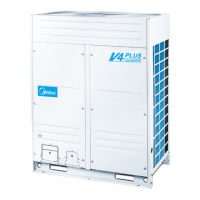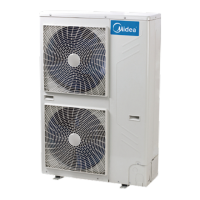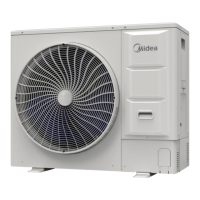V4+R VRF 50/60Hz
201608 91
Part 5 - Diagnosis and Troubleshooting
Step 5: Check filters(s)
If the oil from a compressor is spoiled (lightly or heavily), check the filter between the gas stop valve and the 4-way
valve in that unit. If it is blocked, clean with nitrogen or replace.
Step 6: Replace the faulty compressor and re-fit the other compressors
Replace the faulty compressor.
If the oil had been spoiled and was drained from the non-faulty compressors
in Step 3, use clean oil to clean them before re-fitting them into the units. To
clean, add oil into the compressor through the discharge pipe using a funnel,
shake the compressor, and then drain the oil. Repeat several times and then
re-fit the compressors into the units. (The discharge pipe is connected to the
oil pool of the compressor by the inner oil balance pipe. Refer to Figure
5-4.15.)
Step 7: Add compressor oil
Add 1.2L of oil to the new compressor through the discharge pipe, using a funnel.
Add 1.2L of oil to each of the compressors from which oil was drained in Step 3.
Only use FV68H oil. Different compressors require different types of oil. Using the wrong type of oil leads to various
problems.
Add additional oil to the accumulators such that the total amount of oil is 5L in 8-12HP units and 7L in 14-22HP units.
Step 8: Vacuum drying and refrigerant charging
Once all the compressors and other components have been fully connected, vacuum dry the system and recharge
refrigerant. Refer to the V5 X Engineering Data Book, Part 3.
Figure 5-4.16: Inspecting compressor oil
Figure 5-4.15: Compressor piping
This oil is black
- it has been
yellow, but is clear
and transparent and
the condition is
transparent but there
are impurities which
oil indicates
abnormal
system
This oil contains
